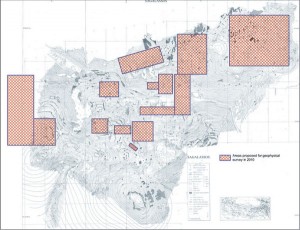The Sagalassos team intends to fulfill its responsibility for the creation of a management plan for the long-term preservation of the site. The methodology of the process entails following steps: 1. definitions: – define the area and the scope of the plan, – define the objectives – identify the stakeholders and decision makers 2. data […]
Read full post »Field Reports for 2010
Site Management: 2010 Aims
Friday, July 9, 2010Macrobotany: 2010 Aims
Friday, July 9, 2010Introduction Macrobotanical remains, consisting of seeds, fruits and wood charcoal will be collected in the trenches and in the sieves, and will be identified. Aims The aim of the research is to reconstruct the former environment and to document the exploitation of that environment by the inhabitants of the site for food and as a […]
Read full post »Geophysical Survey: 2010 Aims
Friday, July 9, 2010
Introduction Since 2002 the urban area of Sagalassos is surveyed with various geophysical techniques with excellent results. We would like to continue this research during the 2010 campaign in a selected number of areas. Aims & Methodology As a measure of preparation the application of geophysical techniques at the site may involve the clearance of […]
Read full post »Geomorphology: 2010 Aims
Friday, July 9, 2010Introduction The geomorphological approach on the site of Sagalassos involves: 1) the study of the geomorphological characteristics of the different terrain units where the town is build and the different buildings are situated, and 2) the study of the impact of geomorphological processes on the site during and after the occupation. Aims The aim of […]
Read full post »Geological Survey: 2010 Aims
Friday, July 9, 2010Archaeometrical study of the craft activities at Sagalassos Introduction A wide range of mineral resources was exploited at Sagalassos, including ores, clays and natural building stones. Aims The aim of the archaeometrical studies at Sagalassos is therefore to characterise artefacts produced by the different crafts, the identification of the raw materials used and the reconstruction […]
Read full post »Archaeozoology: 2010 Aims
Friday, July 9, 2010Introduction Animal remains will be collected in the trenches and in the sieves, and will be identified to species. Aims The aim of the research is to document the food procurement strategies of the inhabitants of the site (importance of domestic stock keeping, of hunting and of fishing), and to reconstruct the former environment. Methodology […]
Read full post »Archaeological Survey: 2010 Aims
Friday, July 9, 2010
Introduction In 2008 a new programme of intensive archaeological surveys in the outer reaches of the ancient territory of Sagalassos was initiated, with the aim of understanding how peripheral areas evolved through time, before, during and after they were annexed by regional centres. During the fieldwork seasons of 2008 and 2009 the Bereket Valley and […]
Read full post »Archaeological Studies: 2010 Aims
Friday, July 9, 2010Pottery studies The territorial survey campaigns, as well as the intensive suburban and urban survey work, and the excavation programmes at Sagalassos and D?ºzen Tepe, have resulted in the outline of ceramic production and use within the territory of ancient Sagalassos between the Iron Age and mid-Byzantine times. During the 2010 campaign, the general aim […]
Read full post »Anthropobiology: 2010 Aims
Friday, July 9, 2010Introduction Anthropobiology is based on the determination of the biological features of past and present human individuals/populations in order to reconstruct their origin, history and evolution. Aims The aims of the anthropo-biological work that will take place during the 2010 campaign in Sagalassos will be to analyze the biological features of the human remains, especially […]
Read full post »Ancient DNA Research: 2010 Aims
Friday, July 9, 2010Introduction Ancient DNA research provides the possibility to study the environment and history of past human populations by the analysis of DNA from biological archaeological finds such as animal, human and botanical remains. Aims It is our aim to provide complementary data to the research performed by other disciplines in Sagalassos such as the pottery […]
Read full post »
